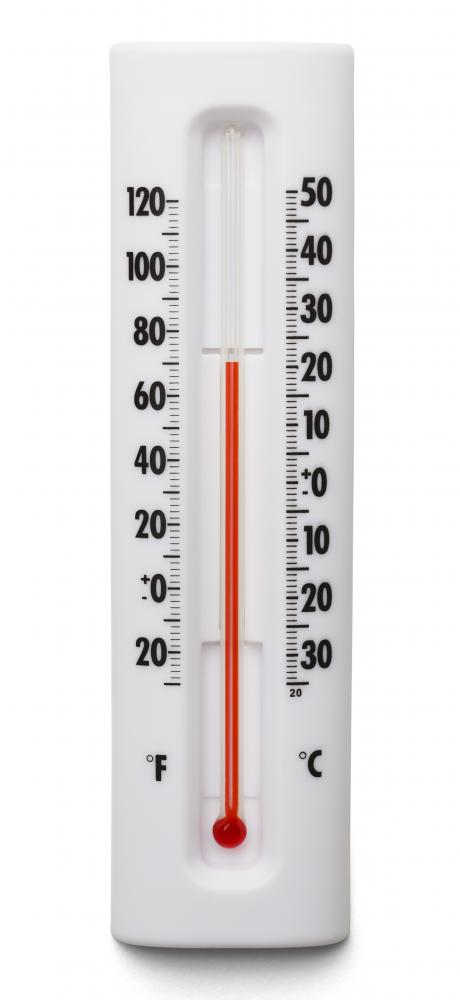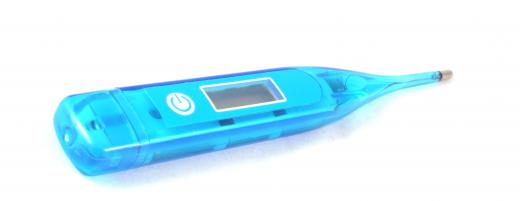What are the Different Types of Thermometers?
 Tricia Christensen
Tricia Christensen
Knowing the temperature of things can be very important. People may need to know when the turkey is fully cooked, or might have to make sure that a child isn’t burning up with fever. In lab testing, precise measurements of temperatures is required frequently, so integrity of experimentation is maintained. When people want to measure illness, whip up candy, or attempt scientific testing, types of thermometers available are always ready to serve.
One of the first distinctions needed when talking about types of thermometers is form of measurement. For all but strictly scientific purpose the most common scales are called Fahrenheit and Celsius, and they may be used differently in varying places around the world. For at home use, people in the US are likely to rely on Fahrenheit thermometers, but at hospitals or doctor’s offices, it might be more common to see the Celsius scale used. In the UK, Celsius is much more commonly used than is Fahrenheit, for example.

Some thermometers offer both readings and others might require conversion. The simple formulas to convert are the following:
C = (F – 32)5/9 and F = 5/9C + 32.
When precise conversion isn’t required, it’s fair to state that Celsius is about one-third of a Fahrenheit reading.
Having explained differences in temperature scale, it is then possible to consider the variety of thermometers. As mentioned, thermometers are widely used in medicine to check the body for fever. Until a few decades ago, those most commonly employed were mercury glass thermometers that could be inserted into the mouth or rectum to determine body temperature. Today, these are not common given the toxicity of mercury.

A host of options have exploded onto the market instead. Small digital thermometers can be cheaply purchased at a pharmacy and might be used to take an oral or axillary (under the arm) reading. There are also fever strips for one-time checks that may be applied to the forehead or placed in the mouth. Ear thermometers analyze temperature, and some devices roll over the forehead to get a reading.

There is no less variety in thermometers that might be purchased for kitchen use. Sturdy meat thermometers may be plunged into cooking meat to determine its temperature. There are also many of these that now can remain in cooking meat while a digital readout screen sits outside the oven. Good cooks know that candy thermometers are vital to making confectionary, since undercooking or overcooking sugar usually won’t result in the right finished product. These could vary from glass types to digital varieties too.

While these are obvious examples, there are a few people may forget. Homes are usually filled with temperature reading devices. They may exist in thermostats and help keep homes cool or warm, and they’re present in refrigerators, ovens, dryers, and water heaters.
Varying types of thermometers are also in computers, and work as a way to signal the computer’s components if a fan needs to be turned on. Even a hairdryer could have a thermostat that automatically turns the dryer off if it reaches a certain temperature. Other places to find examples of types of thermometers include in cars, and in most large machine and plenty of small machines.

Another way of approaching this issue is discussing types of thermometers by the way they work. Mercury ones, for instance, would cause the mercury to climb upward through a small shaft as the temperature rose. This mechanism is similar to how glass alcohol thermometers function.
AS FEATURED ON:
AS FEATURED ON:
















Discussion Comments
I dislike using disposable thermometers for my temperature, and mercury ones sort of frighten me. While I've heard they're less accurate, I prefer battery-powered ones.
I have noticed in a lot of places where I've lived that the thermometers for heating are usually extremely close to heating vents, causing the thermostats to always overestimate the heat of the rest of the house. I wish there was a good way to get around this- the best I have found is to keep thermometers in other parts of the house and try to manually increase the heat based on them, though it doesn't always help the heat circulate any better.
I like using "outdoor" thermometers inside, because they are usually more durable than the ones designed for inside use.
Post your comments